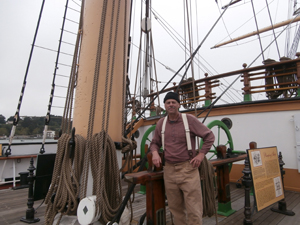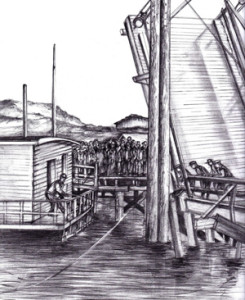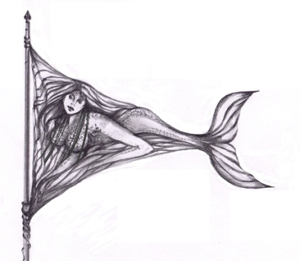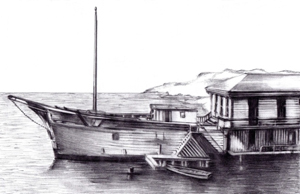The wind suddenly backed the staysail and forced the bow of Alma further to port. Bill tried to bring her head into the wind, but it was impossible without steerageway. At that moment, Ed finally loosened the sheet and untied it from the cleat. As the line slipped through his fingers he looked back around and saw the Commodore moving across the foredeck. “WATCH OUT,” Ed screamed, as the staysail flopped over.
The sail and boom hit Father square on the chest and launched him backward across the foredeck. “Dad?” Ed said as he crawled over to the Commodore. He had to keep low with the boom of the sail swinging uncontrollably overhead. “Dad?” Ed touched his father’s face.
The Commodore opened his eyes, but they seemed vacant. “Uhh…” Dad groaned. A moment later, he began to focus on his son.
“Dad! Are you okay?”
The Commodore looked at the sail, flapping overhead with the sound of a freight train. He sat partway up for a moment, and then dropped back to the deck. Their eyes met. Dad swallowed once, hard. He thought about how his sons had been returned to the ark in disgrace, and that having them work on the scow was supposed to be punishment. But his oldest would have to face his own trial of manhood right now; there was no other choice.
“Get her… moving,” the Commodore said in a weak, halting voice. He looked at his son with a hollow stare, “You are in charge…” His voice trailed off. “Just keep her… moving.”
Ed hesitated for a moment; there was no way he could leave his father like this. “Dad?”
“Alma comes first,” Dad ordered. “Go to zee helm.”
It’s springtime in 1908, the beginning of the 20th Century. San Francisco is on the rebound from the Great Quake of 1906, and amazing advances such as electricity, automobiles, and radio are emerging while, at the same time, spelling the doom of the graceful sailing ships that were the driving force of economic progress for centuries. Brothers Ed (16), Bill (14), and Ted (12) are about to embark on the adventure of a lifetime when their father buys them a 16-foot Whitehall boat, which they christen Mermaid, and sets them loose on San Francisco Bay. That summer, they encounter Teddy Roosevelt’s Great White Fleet; end up the target of pirates who shoot rotten fruit for cannonballs; surmount the rough seas, save the lives of new friends; and deal with the most daunting challenge of all – learning to get along.
And so begins the tale of Mermaid Sails the Bay, by Bay Area author Greg Trybull, whose own father bought a sailboat for the family when Greg was 12. Young Trybull took to the nautical lifestyle like a fish to water, spending his teenage years (the 1970’s) sailing San Francisco Bay, where the idea for this story first took shape.
ALIVE: How would you describe Mermaid Sails the Bay?
Greg Trybull: Mermaid Sails the Bay is a historical fiction adventure that will connect today’s reader with the beginning of the twentieth century. There are numerous sites in the book, including a number with images, which can be visited today.
A: Why did you choose the beginning of the 20th Century as the temporal setting for your book?
GT: This was a transitional period in ship propulsion; sail was still economical for bulk cargos, but coal steamers had taken over much of the shipping industry, due to their regular arrival and departure times. The use of fuel oil was also rising; so all these different types of ships crowded the Bay and waterfront in every picture I’ve looked at.
A: What inspired you to write this story?
GT: My father bought a sailboat in the mid-1970’s. I was the crewman who would run up forward whenever a line hung-up or some deck-hand job needed to be done. Around that time, my aunt in Germany sent me a book titled Swallows and Amazons. It’s a fictional adventure about kids who sail a small boat on a lake in England. Arthur Ransome wrote a number of stories about these characters–I believe there are 13 or14 in the series. I was hooked – for years – and must have read each of those books at least a dozen times.
A: In your book, you write with amazing detail about San Francisco and the Bay as it was in 1908. How much of Mermaid Sails the Bay is based on actual historical events and how much is fictional? 
GT: Chapters 2 and 3 describe actual historical events – the opening of the Belvedere Drawbridge to administer the exodus of the arks in the lagoon, which today marks Opening Day on the Bay, and the arrival of Teddy Roosevelt’s Great White Fleet on May 6th. The fictional adventure never stops once the boys sail for an island in Chapter 4. But Mare Island, the Shortline to Paradise, and the Tavern at Tamalpais are all straight from the history books. Having the U.S. Army in Yosemite is historical fact, but it dropped straight into the plot like a piece of a puzzle.
A: Where did you do your research?
GT: The J. Porter Shaw Maritime Library in San Francisco. I had a great amount of help from the good people who work there. This was where I learned about the primary ships at Hyde Street – Star of Alaska (ex. Balclutha) is a square-rigged windjammer; Eureka (called Ukiah in the time of the story) is a double-ended ferry boat; C.A. Thayer is a “doghole” lumber schooner; plus Hercules and her sister ship were the first sea-going tugs to operate from the Bay (using fuel oil).
A: Tell us the story of Drake’s Plaque?
GT: It is said that the explorer Francis Drake left a plaque of brass somewhere on the shore of Drake’s Bay, to claim all this land for the queen. Around 1936 a plaque was “found” and declared authentic before a rigorous scientific study could be performed. After forty years the plaque was declared a forgery, apparently a good-natured student’s joke that went awry.
A: As a teenage boy sailing the Bay with your family in the 1970’s, how much of this book is autobiographical?
GT: The Dunking Derby is from my time. It’s a Paradise Harbor tradition – sinking someone else’s small-boat on the 4th of July. Plus the scene of sailing in heavy weather was real. We once anchored out overnight in Clipper Cove at Treasure Island. The wind was howling the next day, so we waited a few hours in the hope that it would ease some. But it was summertime – on the Bay that means the wind gets even stronger in the afternoon. So at noon we had no choice but to set out North, straight into the teeth of a near gale. The waves were not enormous, being on the Bay, but every one of them seemed to aim right for us. It should have been a three-hour tour to get home to Paradise Harbor. Near the halfway mark I looked at the distant land with a cringe, because I knew the sun would go down before we could make it home. Then another wave smashed us, throwing the bow backwards with a plume of icy spray for our faces. Something made me peak into the cabin – I gasped at the sight of a puddle sloshing about on the floorboards. “There’s water in the cabin!” I screamed to my dad as I instinctively moved to take the wheel from him. He launched himself down the companionway and quickly found that the knot-meter had been dislodged from below the waterline. That was one of the scariest moments of my life – knowing the Bay was coming in, and the land was so far away.
A: Tell me about the brothers in the book. What makes them such sympathetic, likeable characters?
GT: I don’t know… you’ll have to tell me! I originally identified most with the middle brother, Bill. You must understand that there was no real plot when I started, just an outline about places to go. What drew this idea of a sailing adventure into a complete story was Cap’n Scurvy – or to be more accurate, it was the exchange between Ted and his pirate captain. I can tell you that I did not have an imaginary friend when I was young. I just dreamed about a ship…
A: Was your own father similar to the brothers’ father, the Commodore?
GT: Well… perhaps in small portions. My dad did buy us an El Toro; it’s an eight-foot pram with a sail. During the first moon landing, Dad built us a rocket with scraps from the houses going up all around us. It even had an odometer – that rocket could go 30 mph! It was the talk of the whole neighborhood.
A: In the excerpt above, the boys have to save the Commodore. Was that ever your experience?
GT: It’s not that I ever had to physically save my dad; my contribution was always comments like “We’re too close,” or “We’re too close, start the engine.” My dad would laugh and call me chicken-of-the-sea, until the time we were in Martinez after bringing the boat up for a trip to the Delta. My dad decided to dry the spinnaker (a parachute sail for downwind runs) at the boat, by using a special technique that would spill the wind out of it. But, Martinez is basically a funnel, where all the wind from the ocean pours into the central valley once the land heats up, so I reasoned, pleaded, and then begged to take the sail home for a wash and dry. Of course, Dad thought I was just being C-O-T-S, so he washed the sail and then hung it upside down, on the theory that the wind would spill, because the clews (corners) of the sail were tied together. This theory is true, provided there’s little to light wind. But we were in Martinez, in the afternoon, with the wind at small craft force (15 KPH, that’s Knots Per Hour, slightly more than MPH).
All was well for about five minutes. Then the sail began to fill and started yanking the boat in a forceful motion. My father said, “I guess you were right,” and we proceeded to drop sail. However, this was a parachute sail, that was only attached to the boat with lines, so as I let the halyard out (the line on the mast), my dad couldn’t pull the rest of it to the deck because the wind was so strong. The sail moved further away from the mast, and higher too, and started acting like a kite and pulling the boat away from the dock. I yelled, “I’m letting go,” and I released the halyard, in the hope that the sail would collapse and fall into the water. Having a clean, dry sail didn’t matter anymore; the boat was getting pounded against the dock. “We gotta cut the line,” I yelled. Dad still had hold of the sail’s sheets, so he nodded, and I ran below for the knife. I sawed on the line carefully, because I knew it would whip around the winch and tear any flesh that was in the way when it let go. Thankfully I held my face away, because when it let go I felt the end whip right past my cheek. I would have half a face these days, if I’d been any closer. Unfortunately, the halyard was part wire and part rope, and the splice caught in the block at the top of the mast. At that point the sail was whipping overhead a good fifty feet above the mast – and there was nothing we could do about it.
Thankfully, the block disintegrated under the load, the sail broke free, floated over the next pier, and slowly drifted into the water. We recovered the sail, took it home and tended it the exact way I, formerly known as chicken-of-the-sea, had suggested.
A: How would you classify Mermaid Sails the Bay, and who is your target audience?
GT: It’s been described by my editor as a Young-Adult novel, but I feel that adventurous folks of all ages will be drawn to the story. A few people have mentioned that they’d like to see it on the suggested reading list for California high school students, since it offers so many authentic references to the history of our unique Bay Area.
A: Mermaid Sails the Bay is your first novel, and already it’s receiving high acclaim. What’s next?
GT: Perhaps a sequel – 1914 was a good year on the Bay – and some tales about Cap’n Scurvy. But I’ve already started something completely different, a series of short stories about… me.
Mermaid Sails the Bay is a wonderfully inviting and excruciatingly researched and accurate historical adventure, a tale of life in the Bay Area during a time of grand opportunity and no-holds-barred stomping into a future of promise. Young adults, and those among us no matter how old who aspire for the trappings of their youth, will laugh and cry as they pull for these brothers and live vicariously through their coming-of-age journey.
Beautifully written and illustrated, Mermaid Sails the Bay is ideal for young adults with a thirst for adventure and a desire to know more about the history of the Bay Area — a perfect selection for local schools to include on their recommended reading lists.
Mermaid Sails the Bay is available at Amazon (www.amazon.com/dp/1475289979). To find out more, visit www.MermaidSailsTheBay.com.

Leave a Reply